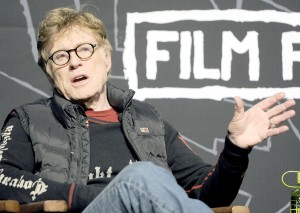USC film students experience Sundance
More than 40,000 people — casual moviegoers and film industry professionals alike — flocked to the quaint resort town of Park City, Utah for the year’s largest and most internationally renowned showcase of independent cinema — the Sundance Film Festival. Now in its celebratory thirtieth year, Sundance has consistently served as a welcome beacon for domestic and international shorts, features and documentaries at a time when studio dominance and corporate, profit-driven filmmaking continues to grow.

Man behind the sun · Robert Redford, founder and president of Sundance, the world’s premiere film festival, spoke at seminars at the festival in Park City, Utah this week. USC cinema students had the opportunity to see the festival’s innerworkings and network with other festival attendees. – Photo courtesy of Sundance Film Festival
A group of USC students found themselves among the attendees, many through a trip organized by Delta Kappa Alpha (DKA), USC’s co-ed professional cinema fraternity.
For some, this was an opportunity to volunteer at the festival, while others used it as an opportunity to hone their ever-important networking skills.
But when so many opportunities abound for rubbing shoulders, it’s often impossible to grasp them all with equal vigor.
“You can easily feel disappointed in yourself,” said Keely Weiss, a senior majoring in writing for screen and television.
Still, Sundance undoubtedly acts as something of a democratizing force for attendees.
Audience members and celebrities alike are bundled up in brightly colored ski jackets to brace themselves against the bitter cold. Prominent distribution executives and agents strike up conversations with volunteers and locals whilst waiting in extensive lines and film recommendations are traded back and forth like candy among strangers united by their love for cinema.
This 10-day bubble of constant film-watching generates an atmosphere alive and buzzing with both business and pleasure as sales are made, talent discovered and films revered in a premonition of some of the theatrical releases that will, with some luck, pepper 2014’s filmic landscape.
“Sundance is a marketing haven,” said screenwriter/producer Marquis Smalls, who attended Sundance for his sixth year this week as part of the entourage representing the feature Dear White People.“ There aren’t many festivals that draw together so many people from the industry in one place; it’s all very condensed.”
Sundance is fundamental for both emerging and established filmmakers looking to attain distribution for their films. As one of the most highly-regarded and attended festivals on the international film circuit, Sundance attracts many up-and-coming independent films, the producers of which bank on breaking through at the festival in order to court wider audiences.
“Sundance is a market,” Weiss said.
Films like the opening night selection Whiplash (inspired by director Damien Chazelle’s short, which premiered at Sundance last year) are indicative of Sundance’s notorious characteristics.
Whiplash is a coming-of-age story starring Miles Teller. Last January, J.K. Simmons sold its international distribution rights to Sony Pictures Classics the very same night it premiered to an extremely receptive Sundance audience.
Unfortunately, many of the films screened at the festival are hard-pressed to obtain similar deals. In 2013, only 75 features obtained distribution deals out of the 119 screened, and many deals were made on limited terms, according to Cultural Weekly.
Though for the majority of the 40,000 visitors, including and especially the many students, the goal is simply the sheer pleasure of escaping class or work to indulge in the newest and most daring independent films.
This year’s most highly regarded films include I Origins, a bold narrative exploration of science fiction and spirituality, Boyhood, Richard Linklater’s cumulative coming of age tale that has been 12 years in the making, and Wish I Was Here, Zach Braff’s kickstarter-funded quirky dramedy.
Festival attendees can purchase individual tickets for $20 each, or splurge on a pass (starting at $1,500) to ensure access. Arabella Weston-Smith, a junior majoring in critical studies, took her chances and chose to scalp tickets and experiment with Sundance’s new smart phone wait-listing app instead.
“I’d advise people to really be on top of it if they choose to do that,” Weston-Smith said. “But luckily I was able to see nine films in five days without paying for a pass.”
The wait-listing app has inevitable kinks as lists of up to 200 ticketless patrons are filled up in a matter of seconds. The system has replaced the wait-listing method of previous years, which saw audiences without tickets lining up outside theaters as early as six hours before popular premieres.
“I wish I had planned a little better and read the program more thoroughly,” Weiss said. She admitted that the combination of an extensive selection and limited ticket purchasing for pass-holders led her to make some snap decisions.
Overall, the Sundance Film Festival offers a unique experience for students interested in the entertainment industry and looking to expand their knowledge of independent film, whether through networking opportunities or innovative screenings.
